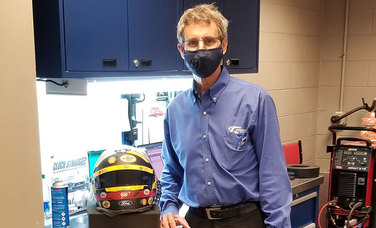Dave Kenny Uses Experience to Help Team Research and Development
August 24, 2020
"Penske Material" provides an inside look at some of the personalities, stories and moments that make Team Penske so unique.
Each work day, every employee at Team Penske walks past the security entrance and down a hallway into the team’s race shop in Mooresville, N.C. Everyone walks past a sign in the hallway that honors the men and women that have been with the company for more than a decade. Listed at the bottom of the first column is Dave Kenny.
Kenny is fast approaching 30 years with Team Penske. The Freedom, Penn., native is one of a handful of team members that have been with Team Penske’s NASCAR program since the 1991 NASCAR Cup Series season.
Perhaps nothing exemplifies “Penske Material” more than hard work, loyalty and longevity. And there’s no better example of that than Kenny, who works with the organization’s Research and Development (R&D) department.
The road to the top level of NASCAR racing for Kenny began in 1978 when he was racing as a high schooler on the dirt tracks of Western Pennsylvania. His love for racing led to a full-time opportunity two years later. But the cost of dirt track racing combined with a downturn in the state’s economy led to a career change.
“We were very successful as a dirt team, but we couldn’t make any money at it,” Kenny said. “I finished up my apprenticeship as a tool and die maker within about six months and there was a massive layoff in Western Pennsylvania so there was really nothing to do long term. I came to North Carolina looking for work.”
 Kenny soon found that opportunity, landing as a fabricator with the Junior Johnson race team and driver Neil Bonnett for the 1986 season before earning a spot on the over the wall crew as jackman midway through the season. One year later, he transitioned to Rahmoc Racing and then came stints at Hendrick Motorsports (1988) and Stavola Brothers Racing (1989-1990) before joining Team Penske. Along the way, Kenny worked with such successful crew chiefs as Harry Hyde and Robin Pemberton and learned a lot about motorsports.
Kenny soon found that opportunity, landing as a fabricator with the Junior Johnson race team and driver Neil Bonnett for the 1986 season before earning a spot on the over the wall crew as jackman midway through the season. One year later, he transitioned to Rahmoc Racing and then came stints at Hendrick Motorsports (1988) and Stavola Brothers Racing (1989-1990) before joining Team Penske. Along the way, Kenny worked with such successful crew chiefs as Harry Hyde and Robin Pemberton and learned a lot about motorsports.
Though he enjoyed five years of working as an over the wall crew member, Kenny didn’t have that opportunity when he first joined Team Penske because the team’s crew roster was already formed.
“In my situation, when I came to work for Team Penske, their first crew was established so there was nothing open at that point,” Kenny said. “And let’s face it, where we are today, there’s no comparison. We had no full-time pit guys or anything like that. You’d have 11 or 12 people on the entire team. We’ve got more than that now support staff.”
 Working in real estate and later serving as a spotter for driver Rusty Wallace helped fill the challenge and excitement that Kenny felt when he was an over-the-wall crew member.
Working in real estate and later serving as a spotter for driver Rusty Wallace helped fill the challenge and excitement that Kenny felt when he was an over-the-wall crew member.
“I started investing in rental property and that became my second job, like if I was on the road at the racetrack,” Kenny said. “The transition came a little easier for me as busy as what we stayed there, but the rental property thing is probably what led to my next step of not being on the road as much. By the time I got (real estate operations) up and going, the spotting deal came up. That was only one day a week. It’s not like it is now where you go continuously. Spotting was just on race day and I enjoyed that.”
While he didn’t travel as much, Kenny and his teammates certainly kept busy. The early days of working at the Team Penske shop is best described with one word: work. With race cars to be built in the days of unlimited testing and a roster of about a dozen team members, there was plenty that needed to be done.
 “Right after Christmas and New Year’s, you could kiss your wife or girlfriend goodbye because until about Easter, you were pretty much wide-open building a fleet of cars,” said Kenny. “We’d be working over 80 hours a week because there was also unlimited testing. We might test three or four times in January. During the season, you tested every week. Tuesday or Wednesday was test day and if things went longer, the guys that were on the road would end up going directly to the race from the test. If there were 30 events there was a minimum of at least 30 test dates.”
“Right after Christmas and New Year’s, you could kiss your wife or girlfriend goodbye because until about Easter, you were pretty much wide-open building a fleet of cars,” said Kenny. “We’d be working over 80 hours a week because there was also unlimited testing. We might test three or four times in January. During the season, you tested every week. Tuesday or Wednesday was test day and if things went longer, the guys that were on the road would end up going directly to the race from the test. If there were 30 events there was a minimum of at least 30 test dates.”
These days, Kenny works with the engineering department on a daily basis and said he likes the variety that comes with his current role. He said some tasks might need to be completed instantly while others might be years in the works from beginning to completion. Two areas that he focuses on through R&D are safety and saving weight in the cars.
“We oversee and manage all the seat development, inserts, belts, anything safety-wise for the drivers,” Kenny said. “And if we do have issues, I’m tapped with getting to the bottom of that. Probably a big thing that I’ve done the last 12-15 years is a weight savings program for the cars and that is ongoing. It never stops.”
Kenny has had a front-row seat for much of NASCAR’s impressive growth since he started full-time in the mid-1980s, much of it fueled by corporate support.
“We came out of a very regional business and it became national,” Kenny said. “The growth was driven by big companies becoming involved, which brought more funding and let the teams expand and grow. In our case at Team Penske, we’ve got over 300 people working on stock cars. There weren’t that many people in the entire field when I started.”
He also credited engineering and technology development for transforming the industry and how cars and built now.
“We’re very much engineering driven at this point,” Kenny said. “How the cars have transformed through that is really amazing when you stand back and think of what we did at one point as opposed to what we’re doing now.”
More Penske Material
Read more about the personalities, stories and moments that make Team Penske unique.

